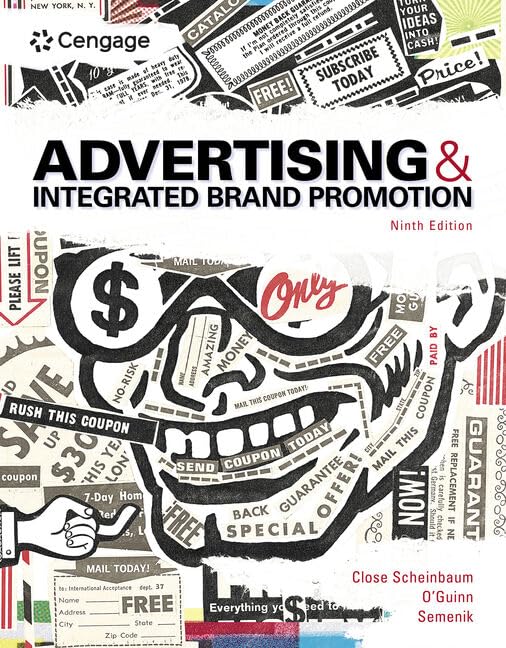Description
Test Bank For Advertising and Integrated Brand Promotion 9th Edition
Chapter 5
|
1. Which of the following enzymes creates a double bond in a fatty acid? a. lipoprotein lipase b. hormone-sensitive lipase c. HMG-CoA reductase d. desaturase e. cyclooxygenase ANSWER: d |
|
2. Which of the following enzymes removes triacylglycerol from plasma? a. lipoprotein lipase b. hormone-sensitive lipase c. HMG-CoA reductase d. desaturase e. cyclooxygenase ANSWER: a |
|
3. Which of the following enzymes mobilizes stored triacylglycerols from adipocytes? a. lipoprotein lipase b. hormone-sensitive lipase c. HMG-CoA reductase d. desaturase e. cyclooxygenase ANSWER: b |
|
4. Which of the following is the rate-limiting enzyme in cholesterol synthesis? a. lipoprotein lipase b. hormone-sensitive lipase c. HMG-CoA reductase d. desaturase e. cyclooxygenase ANSWER: c |
|
5. Which of the following enzymes plays a role in the synthesis of prostaglandins? a. lipoprotein lipase b. hormone-sensitive lipase c. HMG-CoA reductase d. desaturase e. cyclooxygenase ANSWER: e |
|
6. Which of the following risks for cardiovascular disease is associated with trans fatty acids? a. atherogenic fatty plaque b. hypercholesterolemia c. raises LDL-C/lowers HDL-C d. shares structural homology with plasminogen; increases risk of CVD e. increases LDL’s affinity for macrophage receptors causing plaque ANSWER: c |
|
7. Which of the following risks for cardiovascular disease is associated with lipoprotein (a)? a. atherogenic fatty plaque b. hypercholesterolemia c. raises LDL-C/lowers HDL-C d. shares structural homology with plasminogen; increases risk of CVD e. increases LDL’s affinity for macrophage receptors causing plaque ANSWER: d |
|
8. Which of the following risks for cardiovascular disease is associated with saturated and unsaturated fatty acids? a. atherogenic fatty plaque b. hypercholesterolemia c. raises LDL-C/lowers HDL-C d. shares structural homology with plasminogen; increases risk of CVD e. increases LDL’s affinity for macrophage receptors causing plaque ANSWER: b |
|
9. Which of the following risks for cardiovascular disease is associated with apolipoprotein E? a. atherogenic fatty plaque b. hypercholesterolemia c. raises LDL-C/lowers HDL-C d. shares structural homology with plasminogen; increases risk of CVD e. increases LDL’s affinity for macrophage receptors causing plaque ANSWER: e |
|
10. Which of the following risks for cardiovascular disease is associated with cholesterol levels in blood? a. atherogenic fatty plaque b. hypercholesterolemia c. raises LDL-C/lowers HDL-C d. shares structural homology with plasminogen; increases risk of CVD e. increases LDL’s affinity for macrophage receptors causing plaque ANSWER: a |
|
11. What is the range of carbon atoms in fatty acid chains found in foods and body tissues? a. 1 to 3 b. 2 to 6 c. 3 to 12 d. 4 to 24 e. 6 to 20 ANSWER: d |
|
12. Which of the following is true of carbon-carbon double bond in the trans configuration in fatty acids? a. It results in a kinking of the fatty acid into a U-shape b. It extends the fatty acid into a linear shape c. It is required to create saturated fatty acids d. It is the hallmark of essential fatty acids e. It is most commonly found in foods we eat ANSWER: b |

Reviews
There are no reviews yet.